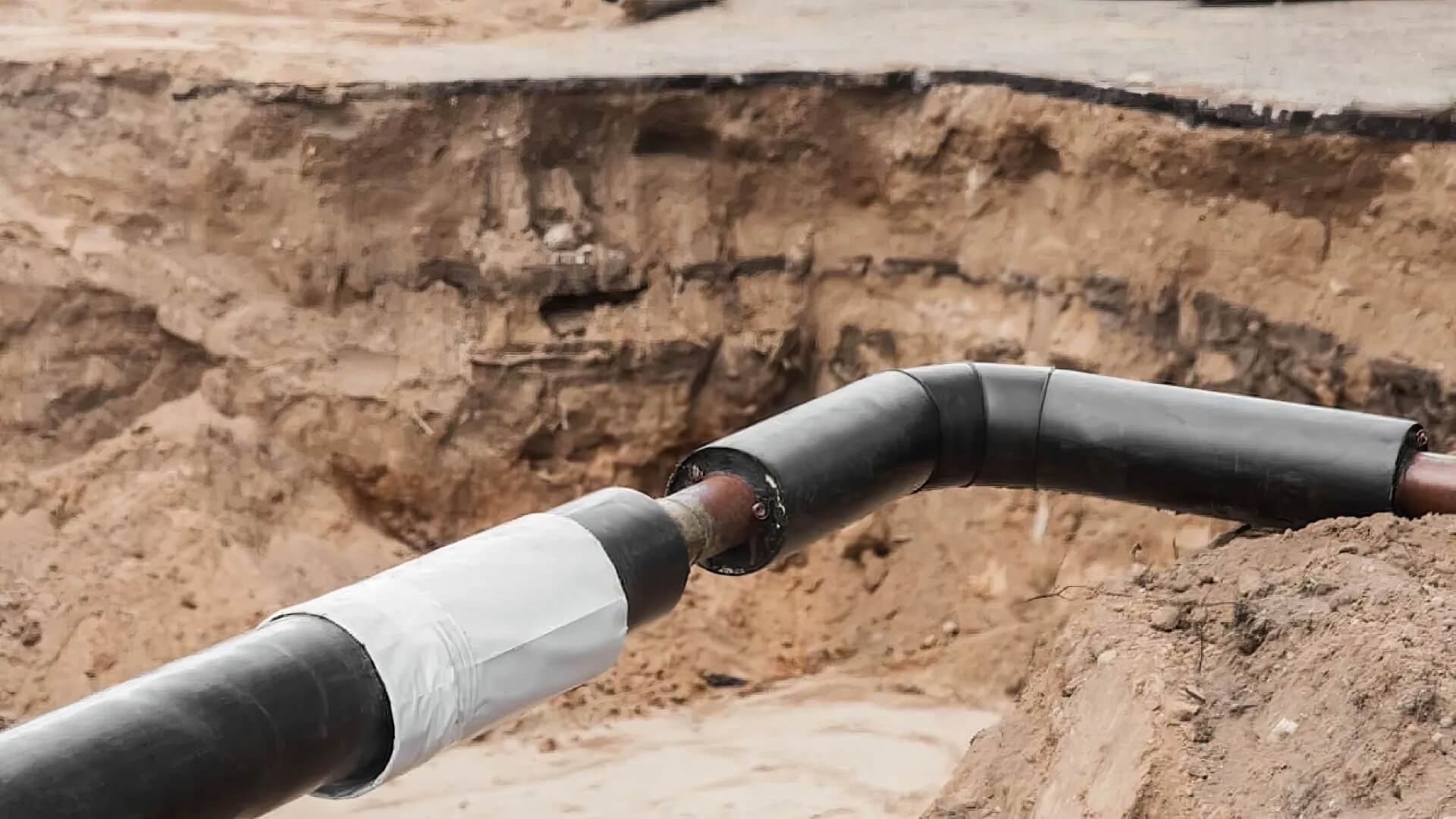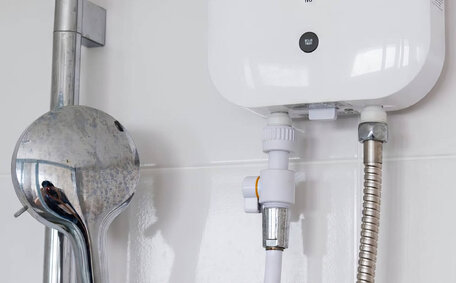Identifying the Source of the Leak
Locating a leak in your hot water system can sometimes be complicated. Signs like pooled water, damp areas near the unit, or higher than usual utility bills can hint at a leak without specifying the location. Ensure safety by powering off your system and shutting off the water supply before inspection.
Begin by examining your water heater’s external surface and proximity of connections for any indications of moisture or corrosion. Common sources include water leaking from loose fittings, cracks in the storage tank, a malfunctioning pressure relief valve or drain valve, damaged anode rod, and more. If a leak isn’t visible, listen for a hissing noise, which may suggest water is escaping.
For gas hot water systems, your system may be suffering from leaks that originate from the gas line, combustion chamber, or exhaust flue.
Scale buildup around fittings in tankless heaters can also contribute to leaks over time. Solar hot water systems can spring leaks at pipe joints.
Hidden leaks may exist within walls or beneath floors if no clear signs are present.
Use a thermal imaging camera to find hot water flow disruptions caused by hidden leaks. Should consistent trouble arise, run a pressure check on your installation to discern where the leak your hot water system emanates. Reach out to a licenced plumber for assistance investigating any leaks your hot water system’s intricate setups might be hiding.
Checking Common Leak Locations
When searching for the origin of a water system leaking, start by methodically checking the components most susceptible to leakage.
- Valves - Corroded, loose, or faulty valves like pressure relief valves, drain valves, and isolation valves frequently cause leaks.
- Pipe connections - Joints and fittings linked to pipes going into/out of the heater often loosen over time, allowing water to escape.
- Tanks - Cracks forming within the inside tank or the outer protective layer, caused by corrosion, harm, or immoderate water pressure, can spawn leaks.
- Anode rod - If corroded, the anode rod hole may leak small amounts of water due to an improper seal.
Check the seals around tank openings for any signs of water leaks or damage.
Investigate the system from top bottom for any dampness or pooling water. For electric heaters, thoroughly inspect for any signs that may suggest a leak. Randomly occurring hot water leaks may stem from excessive water pressure.
Isolate each component and analyse for defects. A consistent drip often signifies pressure your system may be exerting on a potentially loose pipe or another leak source. If necessary, enlist a licensed plumber to assess any potential leaks your hot system might have in the pipes under pressure.
Temperature and Pressure Relief Valves
Temperature and tp valve play an essential role in safeguarding hot water systems. They help guard against excessive temperatures and pressures inside the tank which can cause explosions or water damage on your property.
If you suspect your TPR valve on the gas hot unit is leaking, take these steps:
- Deactivate the power to electric systems, or for gas units, you may need to turn off the main gas flow within your premises.
- Turn off main water supply at the valve located before the water heater.
- Inspect the valve and connected piping for corrosion, damage, or improper installations that may prevent the valve from sealing fully when closed.
- Ensure that the valve drain line is unimpeded and that it flows more freely than more than any previous state. Clogs can obstruct relief flow, leading to leaks.
- Ascertain whether the leak comes from valve seat threading or a defective pressure relief component.
- Should the valve itself be degraded, replace it with a new TPR valve rated to handle leak issues for your hot unit.
- If TPR valve repairs don’t resolve the leak, seek professional aid as excessive pressure might indicate other failing components. Consult a professional plumber for assistance.
Pipe Connections and Gaskets
Leaks in hot water systems commonly arise from pipe fittings and gaskets. As pipes experience temperature variations, they expand or contract, potentially leading to a water system leak due to loosened joints. Gaskets tend to wear over time as well, which means a leak can break the integrity of the water-tight seal.
Warning signs of a leak from pipe connections or gaskets include:
- Water dripping could indicate a leak your plumbing is experiencing
- Rust or corrosion around joints
- Visible dampness or moisture on pipes
- An empty dripping sound at night
To check for leaks:
- Turn off the hot water system’s power and water supply
- It’s vital to check leaks at every pipe joint and connection, watch for signs such as drips, rust, or moistness
- Look for staining or calcification, indicating small leaks
- Check gaskets for cracks, dry rot, or compression failure
- Tighten any loose joints with an adjustable wrench
- Replace worn or damaged gaskets
- Turn water/power back on and check for leaks
- Call in the experts if you can’t fix problem areas where pipes leak after retightening
Replacing old pipe sections or fittings may be needed in some cases. Consult a qualified plumber if DIY fixes don’t resolve your leaking issues.
Preventative Maintenance
Regular maintenance is vital to prevent leaks and maintain your water heating system. Simple upkeep steps you can do include:
- Drain your tank yearly to eliminate sediment build-up and prevent component erosion.
- Testing and adjusting water pressure if too high, usually above 80 PSI
- Replacing the anode rod every 3-5 years to protect against tank corrosion
- Checking pipe connections for tightness and leaks during seasonal inspections
- Monitoring water usage and bills to catch leaks - sudden spikes may indicate issues
Maintain a pristine tank shell and inspect the insulation for any harm to fix potential problems. Contemplate fitting new hot water leak prevention apparatuses, such as leak sensors or automated shutoff valves. Catching a system leaking early not only prevents water damage and mould but also saves on costly repair work down the road.
Draining the Tank
Annual tank draining helps extend its lifespan by preventing sediment build-up and corrosion. Follow these safety precautions and steps:
- Switch off power to an electric tank or turn off gas at the gas valve and extinguish pilot lights on a gas unit.
- Shut the cold water valve situated upstream of the system, which will then supply instant hot water.
- Open a hot tap lever in your house to relieve the system pressure.
- Attach a garden hose to the tank’s drain valve and direct the water to a safe drainage area.
- Open the drain valve to discharge the small amounts water collected at the tank’s base.
- Flush out water until it runs clear. Let the tank completely drain.
- Close the drain valve and remove the hose.
- Gradually turn the water supply back on, allowing the tank to refill.
- Reinstate the power supply to electric water heaters as directed.
Draining removes corrosive deposits, protecting components such as pipes and the tank liner. Doing this annually extends the system’s lifespan and helps prevent leaks caused by corrosion or sediment accumulation.
If draining doesn’t fix an existing leak, other maintenance like replacing the anode rod or servicing valves may be needed. Contact a professional plumber for additional leak troubleshooting and repairs.
Replacing the Anode Rod
The anode rod is a sacrificial metal rod inside your hot water tank that helps prevent corrosion. Over time it corrodes, so replacing it every 3-5 years is essential preventative maintenance.
When replacing an anode rod, always start by ensuring you need turn off power and the water supply:
- Turn off power to an electric tank or consult your licensed hot water supplier to shut off the gas and extinguish pilot lights on a gas unit
- Close the water supply valve and open a hot tap to relieve pressure
- Drain some water from the bottom your tank to reduce weight when working
- Remove the old anode rod located above water heater tank with an adjustable wrench or socket wrench
- Apply thread sealant tape to new anode rod threads
- Screw in new anode rod tightly and ensure proper threading
- Close drain valve and slowly turn water back on to refill tank
- Check for leaks at the new anode connection
- Restart gas water heater as directed or restore power to electric unit
Substitute steel core anode rods in your water heater with aluminium or magnesium ones of identical size. Inappropriate anode rods can hasten corrosion. If unsure, a professional plumber can advise on the best way to replace your system’s anode rod.
Adjusting Water Pressure
Excessive water pressure can cause hot water system issues, including leaks. Pressure above 80 PSI can strain components like storage tanks, valves, and pipe connections.
To check your water pressure:
- Locate the water gauge connected to your home’s water meter to check the pressure.
- Make sure no water is running. The pressure gauge will reveal if any water pressure abnormalities are taking place as it enters your home.
- If pressure exceeds 80 PSI, adjustments are needed to prevent leaks.
To reduce pressure:
- Consult a local plumbing service about installing a pressure limiting valve (PLV). This will regulate pressure.
- As a temporary fix before a PLV is added, slightly close the main water shutoff valve to restrict flow.
- Check pressure again once reduced until safe levels under 80 PSI are reached.
Careful water pressure management helps prevent excessive strain on your system. Check it at least yearly as part of an inspection for leaks or needed repairs.
Step-by-Step DIY Repairs
Some minor hot water system leaks can be repaired through DIY methods. However, gas or electric hot water systems should always be serviced by licenced professionals to ensure safety.
For basic water leaks, you can attempt fixes like:
- Tightening pipe connections with an adjustable wrench
- Replacing worn out gaskets or valves
- Draining the tank and flushing out sediment
- Installing new insulation around the tank if damaged
Always ensure the power is off before beginning repairs on your hot water system. Refer to manufacturer guidelines when replacing specific parts. If you’re deliberating how to mend your own hot water system leak that carries on despite DIY attempts, or if you’re not confident about safe practices, engage a professional plumber at once.
Problems such as gas leaks, electric faults, high water pressure, concealed leaks, or significant leaks require the expertise of a certified plumber. They have specialised tools and knowledge to fully inspect the system and implement solutions. Avoid risk by not attempting to work on hazardous systems unless properly qualified.
When to Call a Professional
It’s crucial to make informed decisions regarding a gas water heater with potential leaks; calling a professional plumber is advised if you detect electrical issues, or lack the skills to safely work on hot water systems. It’s also best to get help right away if you:
- Hear hissing indicating a gas leak
- See pooling water or very damp areas
- Notice a substantial increase in your water bills
- Have a large leak that persists after DIY efforts
- Can’t determine exactly where leak is coming from in your hot water system
Our licenced plumbers at Erkine Park Plumbing are available 24/7 to fix problems such as inspecting leaks and getting your hot water flowing again quickly. Call 1300 349 338, email jobs@erskineparkplumbingservices.com.au, or book an appointment for Professional assessment and mending of water heater leaking.
Preventing Future Leaks
Preventing potential problems, such as leaks in the hot water tank, involves regular maintenance and prompt repairs as issues arise. Some tips include:
- Inspect the system annually to see how leaks, corrosion, damage, etc., are affecting it. Check pipe connections, valves, the tank exterior, and other components.
- Replace the anode rod every 3-5 years to protect the inner tank from corrosion.
- Drain the hot water tank yearly to flush out sediment and minerals that can lead to corrosion.
- Monitor water pressure and install a pressure limiting valve if over 80 PSI.
- Repair minor leaks immediately before they worsen and lead to further damage.
- Adhere to all manufacturer guidelines for maintenance and servicing.
Identifying minor issues promptly and applying preventative care lets you avoid major leaks the hot water system can otherwise face down the track. For significant leaks or complete hot water failure, contact a local plumber promptly to prevent flooding and other severe problems.






